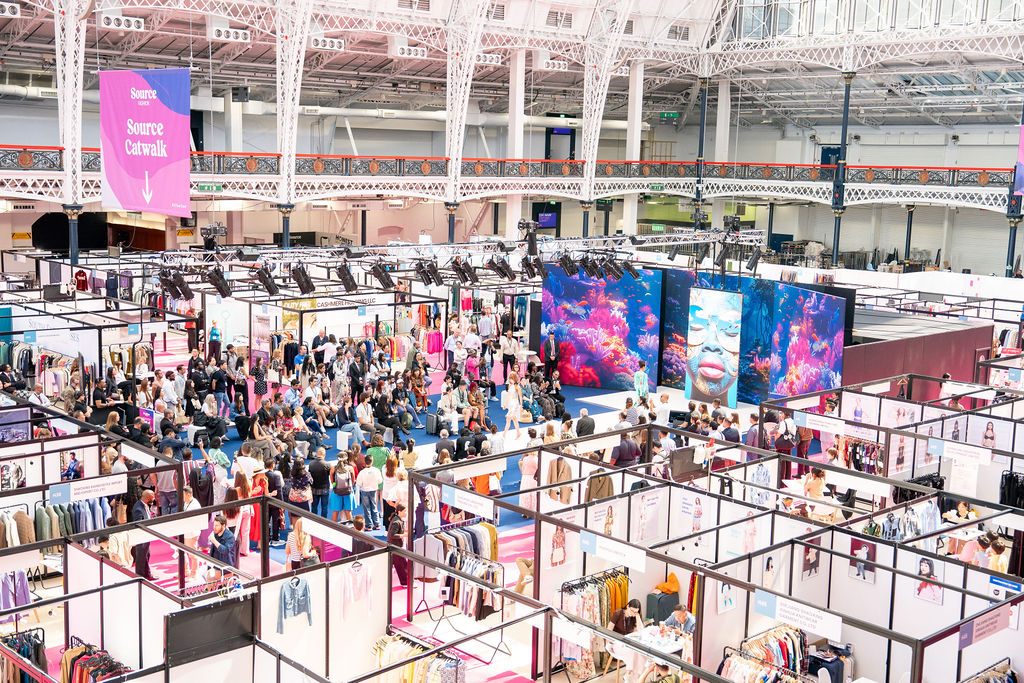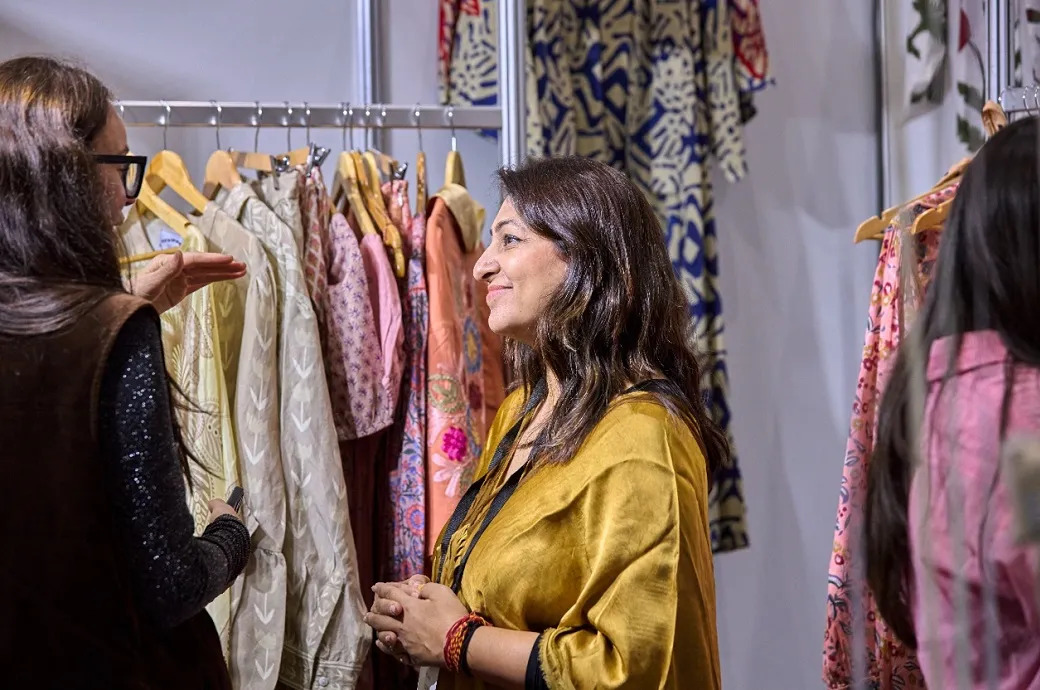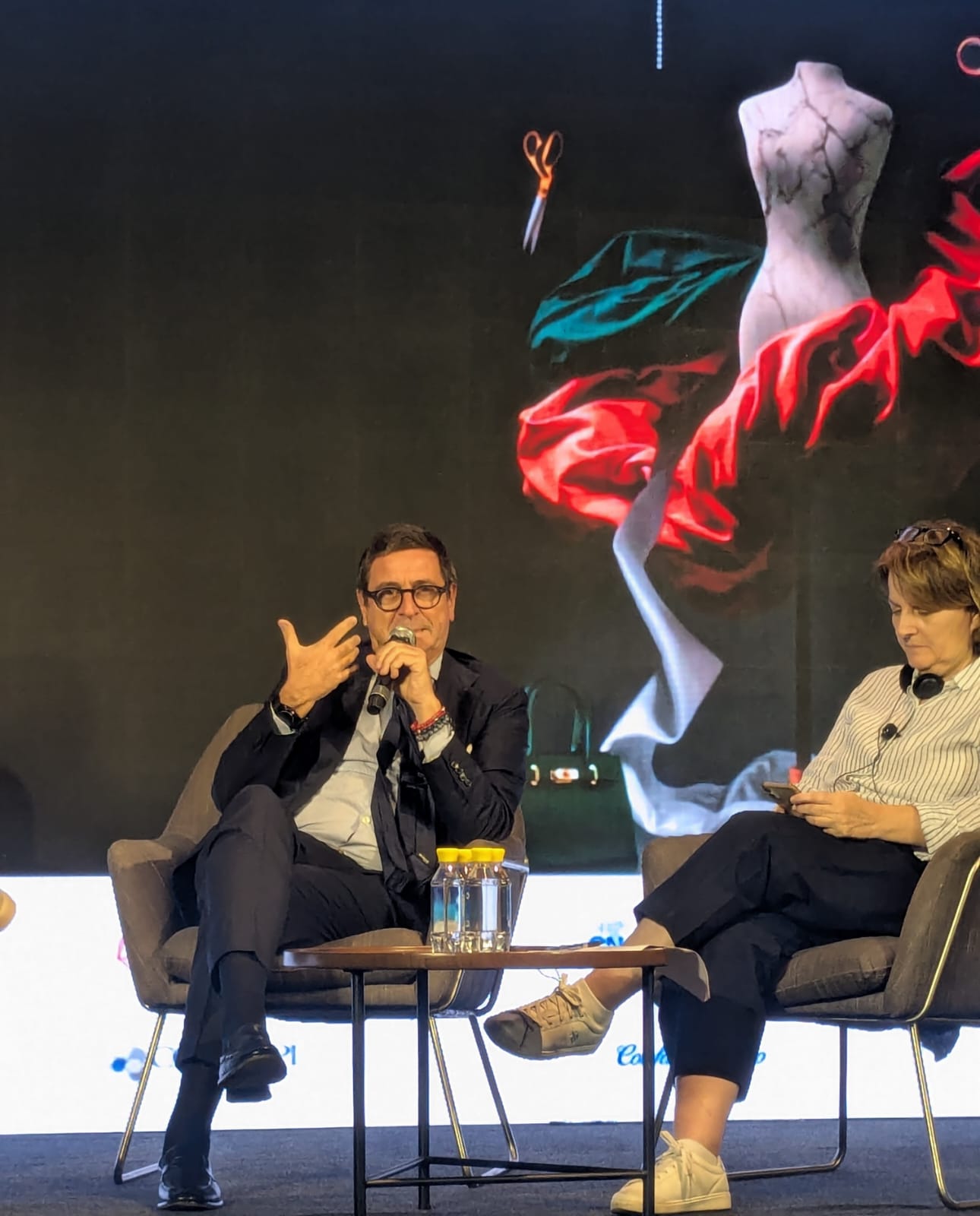FW
Isko is set to showcase its latest fabric innovations and commitment to sustainability at Bluezone, demonstrating its ongoing dedication to blending comfort, performance, and contemporary design. The brand’s SS26 collection features innovative technologies and a strong focus on circularity, ensuring high-performance denim that meets the industry’s increasing demand for eco-friendly practices.
At the heart of the collection is Isko Comfort2, a pioneering fabric that combines the softness and elasticity of knit fabrics with the durability and strength of woven denim. This innovative weave, featuring stretch in both the warp and weft, delivers exceptional comfort and movement while maintaining the strength required for everyday wear. Alongside Isko Comfort2, visitors will explore other advanced technologies like Isko Blue Skin and Isko Reform for 360 degree stretch and the perfect fit across various weights.
The collection also highlights Isko’s commitment to eco-conscious practices, featuring Isko Multitouch technology, which offers diverse textures and 3D effects without the use of harsh chemicals, as well as Isko Iconic finishes that enhance denim’s texture, contrast, and shine using environmentally responsible coatings and resin-wash effects. Additionally, Isko’s new Corduroy collection blends soft comfort with durability, making it ideal for long-term wear.
In line with its sustainability goals, Isko integrates RE&UP’s Next-Gen recycled materials into the SS26 collection, ensuring high-quality denim with minimal environmental impact. Marco Lucietti, Director of Strategic Projects at Isko, emphasizes the importance of connecting with industry leaders at Bluezone to drive forward a more sustainable and innovative denim future.
Isko will also engage in the Denim Innovation Speed Talk and Denim Masterclasses, where experts will discuss the future of denim, sustainability, and technological advancements shaping the industry.
Source Fashion, Europe's premier responsible sourcing event, will return to Olympia London from February 18th to 20th, 2025. The show will place a strong emphasis on UK suppliers and British craftsmanship, offering a diverse range of specialisms, from premium wovens to upcycling. The event serves as a key platform for both small clothing firms and global brands, with a focus on responsible manufacturing.
Suzanne Ellingham, Event Director, notes, “The UK is renowned for its excellence in fabrics and textiles and continues to lead the way in responsible manufacturing. Source Fashion provides a space for all, from small brands to large global names, to connect and showcase their capabilities.”
Several UK manufacturers are set to shine at the event, including National Weaving, a Welsh family-operated business known for premium woven and printed labels since 1987. Caroline Astley, Director, explains that the company’s commitment to high-quality craftsmanship and sustainability remains at its core.
Another standout is The Natural Fibre Company, based in Cornwall, which specializes in premium yarns made from sustainable natural fibers like wool, alpaca, and mohair. Sarah Hemingway, of The Natural Fibre Company, highlights the company’s dedication to “farm-to-garment” production and its work with rare breeds to deliver premium materials.
Circular Inc, an upcycling leader based in Brighton, will also exhibit its innovative approaches to fashion sustainability. Using CLO, a 3D fashion design software, Circular Inc has significantly reduced development time and costs while promoting circular design and repair.
Other notable exhibitors include Anezay, a global manufacturer with ethical production partnerships in the UK and China; Global Leic, a garment manufacturer focused on ethical practices with facilities in Morocco and Pakistan; and Modern Star Silk, a sustainable silk manufacturer in London known for its eco-friendly dyeing methods.
Source Fashion 2025 will provide an essential meeting point for manufacturers and designers aiming to shape the future of sustainable fashion, with exhibitors covering everything from raw materials and fabrics to contract manufacturing services.
Bangladesh's apparel exports to the European Union increased by 24.09 per cent to €1.53 billion ($1.57 billion) in November 2024, primarily driven by easing inflation and declining interest rates in Western nations. This boost in demand for Bangladesh's apparel came as the EU's economic recovery gained momentum, with shipments showing consistent growth over four months leading up to November, according to Eurostat data.
In the first 11 months of 2024, Bangladesh's apparel exports to the EU showed positive growth in six months, with four months seeing double-digit increases ranging from over 20 per cent to nearly 34 per cent. Although some months experienced negative growth, the overall trend was positive. Notably, apparel exports to the EU’s largest market rose by 2.53 per cent, surpassing the global average growth of 0.34 per cent.
Bangladesh’s apparel exports continued to thrive, maintaining its position as the second-largest apparel exporter to the EU, just behind China. Bangladesh’s cost-effectiveness, increasing focus on sustainability, and the shift of orders from China due to trade tensions have all contributed to its success.
Knitwear exports from Bangladesh increased by 0.89 per cent to €10.05 billion, while woven garment exports saw a more substantial rise of 5.13 per cent, growing from €6.35 billion to €6.67 billion. The strong recovery in shipments during the EU's peak retail season from August to November 2024 reflects the growing demand for high-value-added products.
Abdullah Hil Rakib, Managing Director, Team Group, emphasized, Bangladesh's growth is linked to the EU’s recovery from ongoing wars and inflation. However, he raised concerns about proposed energy price hikes and potential labor wage increases, which could affect the country’s competitiveness. Despite these challenges, there remains optimism for sustained growth in Bangladesh's apparel exports, driven by favorable global demand and government support.
Despite challenges like sluggish trade recovery, fluctuating oil prices, rising shipping costs, and energy security concerns, Vietnam's textile and garment industry showcased resilience amid a turbulent global economy in 2024. The industry achieved an impressive export turnover of $44 billion, an 11.26 per cent increase from 2023, and maintained its position as the world's second-largest textile exporter after China.
The US remained Vietnam’s top export market, accounting for nearly 38 per cent of total exports, with turnover rising by 12.33 per cent to $16.71 billion. Japan, the EU, South Korea, and ASEAN markets also showed steady growth. Import turnover climbed to $25 billion, resulting in a trade surplus of $19 billion.
The Vietnam Textile and Apparel Association (VITAS) attributes this success to strategic adaptability. Vu Duc Giang, Chairman notes, the industry reacted proactively with markets diversification, adoption of advanced technologies, and leveraging new-generation free trade agreements (FTAs) with zero tariffs on various product lines. Orders surged in the second half of 2024, boosting revenues and positioning Vietnam to capitalize on global shifts, such as U.S. tariffs on Chinese textiles.
Major companies like Vinatex exceeded targets, with consolidated revenues rising by 2.8 per cent to $724 million over 2023. Other leaders, such as Hoa Tho Textile and Phong Phu Corporation, also surpassed goals, reflecting robust operational strategies and investments in automation.
Looking ahead, the industry aims to grow its exports to $47-48 billion in 2025. Vinatex plans to integrate its supply chain, focusing on automation, smart factories, and reducing manual labor. Similarly, Phong Phu Corporation is targeting $104 million in revenue by innovating products and cutting costs.
Hung Yen Garment, with orders secured through mid-2025, aims to triple its free-on-board (FOB) orders. Investments in eco-friendly practices, digital tools, and workforce development are central to its strategy.
The EU’s Green Deal and transport regulations are driving climate neutrality, prioritizing sustainable fuels like second-generation biomass and synthetic carbon dioxide based alternatives in aviation and shipping. A report by the Renewable Carbon Initiative (RCI) highlights how these policies, while boosting demand for biofuels, could significantly impact other industries, including textiles and yarn production.
The competition for second-generation biomass is intensifying as aviation and shipping quotas absorb most of the available supply. This leaves limited renewable carbon resources for the textile industry, which increasingly relies on bio-based inputs for sustainable fiber production. With prices rising due to fuel sector demand, yarn manufacturers may face challenges in accessing affordable, renewable feedstocks essential for producing eco-friendly textiles.
However, the report identifies synergies. By-products like bio-based naphtha from Sustainable Aviation Fuel (SAF) production can serve as high-quality feedstock for chemicals, potentially benefiting fiber production. Additionally, redirecting food and feed crops toward industrial use could stabilize supply chains without compromising food security.
Innovative strategies, such as integrating electrification in transport with carbon recycling, could create a balanced approach, supporting the textile sector’s defossilization. Policies that encourage a cascading use of biomass and prioritize circularity are critical to aligning the textile industry’s goals with broader climate targets.
RCI urges policymakers to foster cross-sector collaboration and implement balanced policies to ensure sustainable resource allocation. For the textile industry, these measures are pivotal to achieving a resilient, low-carbon future while maintaining competitive global production.
The Karnataka Household and Garment Association (KHAGA) has urged Nirmala Sitharaman, Union Finance Minister to abandon the idea of revising Goods and Services Tax (GST) rates for the apparel and textile industry.
The revision would have a profound impact on the industry’s pricing, production, and also demand, KHAGA emphasized. Additionally, it would result in possible job losses in the industry, intensifying the current financial strain experienced by it, the association added.
Prakash Bhojani, President, KHAGA states, if categorized under luxury tax, ethnic garments, typically bought for weddings and celebrations, will become unaffordable for many. This could reduce consumption during cultural and festive occasions, ultimately slowing down the economy, he adds.
Reforming the GST rates could drive firms and consumers to unofficial marketplaces resulting in sufferings for respectable retailers while illegitimate merchants will continue to profit from this change, he adds further.
To be held from February 1-6, 2025 at the Dubai Design District (d3). Dubai Fashion Week will showcase Autumn/Winter 2025-26 collections. Positioned ahead of Paris, Milan, New York, and London on the global fashion calendar, this edition will feature over 30 international brands, showcasing the region's growing influence in luxury fashion and design.
Designers from across the world including France, India, Indonesia, Iraq, Kuwait, Lebanon, Morocco, Russia, Turkiye, and the UAE, will participate in this show, highlighting the Middle East's rich craftsmanship and design talent.
The event will commence with the Instagram DFW Party and proceed with previous initiatives like Round Table discussions. Khadija Al Bastaki, Senior Vice President, Dubai Design District, states, Middle East’s growing demand for luxury fashion and its diverse craftsmanship continues to position it as a thriving hub for design talent.”
Several global fashion houses will make their debut at this year’s edition of the event. These will include the Australian couture house Paolo Sebastian and Istanbul-based Les Benjamins. New York-based British-Iraqi designer, Tara Babylon will launch her first avant-garde eveningwear collection while Indian couture house Manish Malhotra will close the week with a grand finale.
Renowned brands like BLSSD, Michael Cinco, Lama Jouni, and Dima Ayad will also return to the show with their collections.
In addition to runway shows, the event features exclusive gatherings hosted by That Concept Store and Etoile Boutique, along with city-wide activations. The final day will host private presentations for buyers, offering an exclusive look at collections from regional and global talent.
Emphasising the signifance of the event, Mohammed Aqra, Chief Strategy Officer, Arab Fashion Council, says, Dubai Fashion Week continues to demonstrate the city’s ability to unite a global community, from its diverse roster of designers to the international buyers it attracts.
With its mix of established and emerging talent, Dubai Fashion Week 2025 promises to solidify the city’s position as a leading force in the global fashion industry.

The Regional Comprehensive Economic Partnership (RCEP) has been in effect for over two years, and its impact on the textile and apparel industry is becoming increasingly clear. The free trade agreement, covering 15 Asia-Pacific nations, has significantly altered trade flows in the sector, creating opportunities and challenges for businesses across the region. RCEP, which includes major textile producers and consumers like China, Japan, South Korea, and the ASEAN countries, has streamlined trade processes and reduced tariffs. This has led to a boost in intra-RCEP textile and apparel trade, reshaping supply chains and influencing investment decisions.
China’s dominance and ASEAN’s influence
China has emerged as a dominant player within RCEP, leveraging its massive production capacity and competitive pricing to capture a significant share of the intra-bloc market, particularly in yarns and fabrics. Meanwhile, ASEAN countries, with their lower labor costs and growing manufacturing capabilities, are attracting increased investment and becoming key players in the apparel segment, particularly in finished garments.
RCEP is also encouraging companies to source inputs and intermediate goods from within the bloc, leading to a strengthening of regional supply chains. What’s more, the agreement is fostering innovation and competition, pushing companies to upgrade their technologies and improve product quality to stay ahead.
Table: Intra-RCEP textile and apparel trade (2022)
|
Country |
Exports ($bn) |
Imports($bn) |
Major export products |
Major import products |
|
China |
95.02 |
23.45 |
Yarns, fabrics, finished apparel |
Raw cotton, specialized textiles |
|
Vietnam |
44.2 |
28.7 |
Apparel, footwear |
Fabrics, yarns |
|
South Korea |
15.6 |
12.3 |
Synthetic fabrics, technical textiles |
Apparel, raw materials |
|
Japan |
10.8 |
18.5 |
Specialized textiles, high-performance apparel |
Apparel, home textiles |
|
ASEAN (total) |
120.3 |
85.6 |
Apparel, footwear, home textiles |
Fabrics, yarns, raw materials |
|
Australia |
2.1 |
8.9 |
Wool, raw materials |
Apparel, home textiles |
|
New Zealand |
1.5 |
3.2 |
Wool, natural fibers |
Apparel, home textiles |
Note: This table is based on available data from various sources and may not be fully comprehensive.
Product-wise China leads, Vietnam makes a mark
Fibers: Raw cotton remains a significant import for many RCEP countries, with Australia and New Zealand emerging as key suppliers. Synthetic fibers are largely traded within the bloc, with South Korea and China being major exporters.
Table: Top traded textile and apparel Products within RCEP (2022)
|
Product Category |
Estimated trade value ($bn) |
Major exporters |
Major importers |
|
Apparel |
180 |
China, Vietnam, Bangladesh, Cambodia |
Japan, Australia, New Zealand, South Korea |
|
Yarns |
60 |
China, India, Vietnam |
Cambodia, Laos, Myanmar |
|
Fabrics |
85 |
China, South Korea, Taiwan |
Vietnam, Thailand, Indonesia |
|
Raw Cotton |
20 |
Australia, India, United States (outside RCEP) |
China, Vietnam, Bangladesh |
|
Synthetic Fibers |
35 |
South Korea, China, Japan |
Vietnam, Thailand, Indonesia |
Yarns: China dominates yarn exports within RCEP, supplying a wide range of yarns to other member countries for use in apparel and textile production. The reliance on raw cotton imports, particularly from outside RCEP (like the US), indicates a potential vulnerability for the bloc. This highlights the need for diversification of sourcing and increased production of raw materials within RCEP. The significant trade in synthetic fibers reflects the growing demand for these materials in various applications, from apparel to industrial uses.
Fabrics: A wide variety of fabrics are traded within RCEP, with China and South Korea exporting higher-value synthetic and specialized fabrics, while ASEAN countries focus on cotton and blended fabrics.
Apparel: Apparel constitutes the largest share of intra-RCEP trade in the textile and apparel sector. This highlights the significant role of RCEP in facilitating the flow of garments within the region. Trade is dominated by China and ASEAN countries, with Vietnam and Bangladesh emerging as major garment exporters.
In fact, the data suggests that China and Vietnam have emerged as major beneficiaries of RCEP in the textile and apparel sector. China's dominance in yarn and fabric production, coupled with Vietnam's rising apparel manufacturing prowess, has allowed them to capitalize on the increased market access and reduced tariffs within the bloc. This has led to concerns that other RCEP members, particularly those with less developed textile industries, may struggle to compete.
Table: Estimated Intra-RCEP Textile and Apparel Trade (2023 and 2024)
|
Country |
Exports ($bn) |
Imports ($ bn) |
Major export products |
Major import products |
|
China |
||||
|
2023 |
102.0 (est.) |
25.0 (est.) |
Yarns, fabrics, finished apparel |
Raw cotton, specialized textiles |
|
2024 |
108.0 (est.) |
26.5 (est.) |
Yarns, fabrics, finished apparel |
Raw cotton, specialized textiles |
|
Vietnam |
||||
|
2023 |
48.0 (est.) |
31.0 (est.) |
Apparel, footwear |
Fabrics, yarns |
|
2024 |
52.0 (est.) |
33.5 (est.) |
Apparel, footwear |
Fabrics, yarns |
|
South Korea |
||||
|
2023 |
16.5 (est.) |
13.0 (est.) |
Synthetic fabrics, technical textiles |
Apparel, raw materials |
|
2024 |
17.5 (est.) |
13.8 (est.) |
Synthetic fabrics, technical textiles |
Apparel, raw materials |
|
Japan |
||||
|
2023 |
11.5 (est.) |
20.0 (est.) |
Specialized textiles, high-performance apparel |
Apparel, home textiles |
|
2024 |
12.0 (est.) |
21.5 (est.) |
Specialized textiles, high-performance apparel |
Apparel, home textiles |
|
ASEAN (total) |
||||
|
2023 |
130.0 (est.) |
92.0 (est.) |
Apparel, footwear, home textiles |
Fabrics, yarns, raw materials |
|
2024 |
140.0 (est.) |
98.0 (est.) |
Apparel, footwear, home textiles |
Fabrics, yarns, raw materials |
|
Australia |
||||
|
2023 |
2.3 (est.) |
9.5 (est.) |
Wool, raw materials |
Apparel, home textiles |
|
2024 |
2.5 (est.) |
10.0 (est.) |
Wool, raw materials |
Apparel, home textiles |
|
New Zealand |
||||
|
2023 |
1.6 (est.) |
3.5 (est.) |
Wool, natural fibers |
Apparel, home textiles |
|
2024 |
1.7 (est.) |
3.8 (est.) |
Wool, natural fibers |
Apparel, home textiles |
This table based on preliminary data, industry reports, observed in 2022 shows some clear trends.
Continued growth: Intra-RCEP textile and apparel trade continued growing in 2023 and 2024, driven by ongoing tariff reductions and increasing regional integration.
China's steady dominance: China maintained its dominant position in the bloc, with exports continuing to outpace imports.
ASEAN's expansion: ASEAN countries further expanded their role in apparel production and exports, capitalizing on their competitive labor costs and growing manufacturing base.
Supply chain resilience: The COVID-19 pandemic and geopolitical tensions highlighted the importance of resilient supply chains. RCEP is likely to have encouraged further diversification and regionalization of supply chains within the textile and apparel sector.
Sustainability concerns: Increasingly, consumers and governments are demanding greater sustainability in the textile and apparel industry. This trend is likely to have influenced sourcing decisions and production practices within RCEP.
India's decision, a missed opportunity?
India, a significant textile and apparel producer, opted out of RCEP in 2019 due to concerns about potential flooding of its market by cheaper Chinese goods. While this decision may have protected some domestic industries in the short term, it has also raised questions about whether India is missing out on the potential benefits of increased regional trade and integration. Some analysts argue that India could have leveraged its strengths in cotton production and skilled labor to become a major player in the RCEP market.
RCEP is still in its early stages, and its full impact on the textile and apparel industry will unfold over time. However, it is clear that the agreement is reshaping the regional landscape, creating a more integrated and dynamic market. Businesses that can adapt to these changes and leverage the opportunities presented by RCEP are well-positioned for success in this evolving market.
Ludhiana-based pioneering sustainable manufacturer Rudra Ecovation presented its cutting-edge upcycled range of fabrics at Heimtextil 2025, held in Frankfurt, Germany, from January 14-17, 2025.
The company unveiled a collection of premium sustainable fabrics titled,Anaura. Crafted from recycled PET bottles, the range includes Anaura Home, a range of upcycled fabrics for home furnishings; Anaura Athleisure, a high-performance, eco-conscious fabrics range for activewear and sportswear, and Anaura Fashion, a trendy and sustainable fabrics range blending style with responsibility for fashion applications.
Besides fostering partnerships in international market, Rudra Ecovation aims to strengthen its global footprint by participating in international events like Heimtextil. The participation enables the company to not only showcase its products but also inspire a collective shift towards sustainability says VK Goyal, CEO and Executive Director.
Founded on innovation, Rudra Ecovation operates a state-of-the-art 100-acre facility in Ludhiana, capable of recycling 8.8 million PET bottles daily. This process saves approximately 140,000 metric tons of CO2 emissions annually, making it a leader in eco-friendly manufacturing. The facility produces 320,000 sq m of Anaura fabrics in diverse weaves, widths, and GSMs, along with products like RPET yarn, RPET flakes, and acoustic panels.
An internationally renowned trade fair for home and contract textiles, Heimtextil serves as a global hub for textile innovation and design. In 2025, the event hosted over 3,000 exhibitors and 50,000 trade visitors from more than 60 countries, providing an ideal platform for networking and business expansion. The exhibition enabled Rudra Ecovation to connect with like-minded partners who share the company’s vision for a sustainable future, says Isani Malhotra, Director.
Combining innovation, responsibility, and performance to meet the growing global demand for eco-conscious solutions, Rudra Ecovation continues to lead the charge in sustainable textiles.

The Wirkin phenomenon, a Walmart version of the iconic Hermès Birkin bag, sparked a debate about accessibility, status, and design ethics in the world of luxury fashion.
The Birkin’s Legacy
The Hermès Birkin bag, handcrafted from the finest leathers and often adorned with precious metals and jewels, is more than just an accessory. It's a symbol of wealth, exclusivity, and unparalleled craftsmanship. Its origin’s story which was a chance encounter between actress Jane Birkin and Hermès chief executive Jean-Louis Dumas on a flight in 1984, adds to its allure. The bag's exclusivity is increased by its notoriously long waiting lists and price tags that can range from tens of thousands to millions of dollars.
The rise of the Wirkin
Fast forward to late 2024, and a new bag emerged on the scene – the ‘Wirkin’. a Walmart version of the Birkin, retailing for around $80. The price disparity, a difference of over 100x, is at the heart of the Wirkin phenomenon. The Wirkin, with its strikingly similar design elements – the trapezoidal shape, the flap closure, the metal hardware – quickly went viral on social media, sparking a frenzy among shoppers and a heated debate in the fashion world.
Accessibility vs. exclusivity
Pro-Wirkin: Supporters of the Wirkin argue that it democratizes fashion, making a coveted style accessible to those who could never dream of owning the original. They see it as a fun, affordable way to participate in a trend without breaking the bank.
Anti-Wirkin: Critics, on the other hand, see the Wirkin as a blatant knock-off that undermines the craftsmanship, heritage, and exclusivity of the Birkin. They argue that it devalues the original and feeds a culture of fast fashion and disposable consumption.
A social media frenzy, the hashtag #Wirkin garnered millions of views on TikTok, with users showcasing their purchases and styling tips. "The Wirkin is a win for fashion lovers who want style without the hefty price tag," says a TikTok user who posted a video about the bag. This viral trend highlights the power of social media in driving consumer behavior and challenging traditional fashion norms. While exact sales figures for the Wirkin are not available, anecdotal evidence and media reports suggest a big boost in demand for the bag, with some styles selling out quickly. This indicates a strong consumer appetite for affordable alternatives to luxury goods. The Wirkin also raises questions about intellectual property and design protection. While the bag doesn't bear the Hermès logo or trademarks, its close resemblance to the Birkin could potentially lead to legal challenges. "The Birkin is not just a bag; it's an investment, a piece of art," argues a luxury fashion blogger. "The Wirkin cheapens that legacy."
The Birkin vs. Wirkin debate highlights the tension between accessibility and exclusivity in the fashion industry. While the Wirkin may be a fleeting trend, it has sparked a conversation about the value of luxury, the role of social media in shaping consumer preferences, and the ethics of design inspiration. The sheer volume of Wirkin consumption, driven by its affordability and viral appeal, stands in stark contrast to the carefully controlled scarcity and exclusivity of the Birkin. Whether you see it as a democratizing force or a cheap imitation, the Wirkin has undeniably left its mark on the fashion landscape, forcing us to re-examine our relationship with status, accessibility, and the meaning of true luxury.












